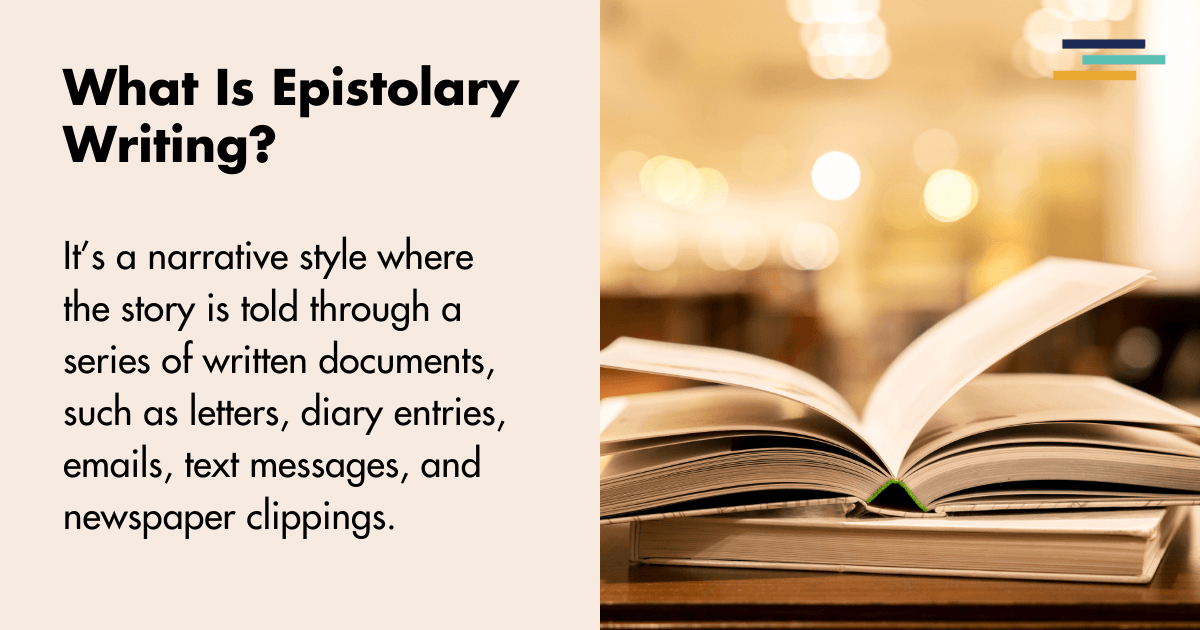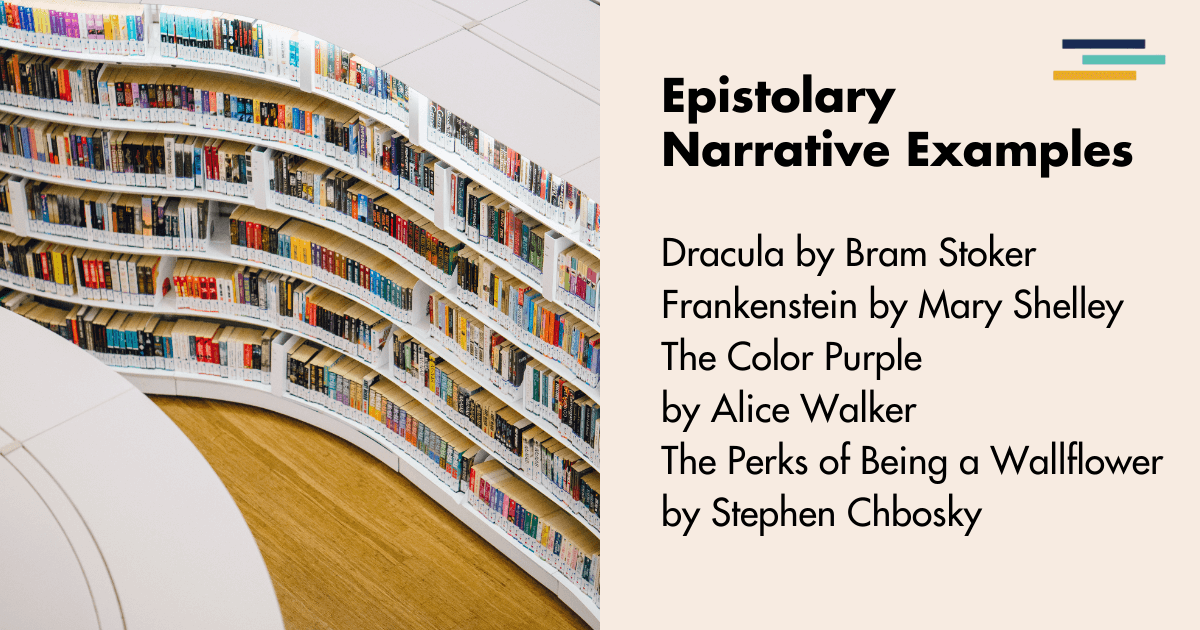
Epistolary novels offer readers something special. `A window into characters’ personal thoughts and emotions through letters, diaries, emails, or other forms of written communication.
This style of writing creates an intimate, direct connection between the character and the reader, making the story feel immediate and authentic.
Authors have used the epistolary format across genres, from gothic horror to contemporary fiction, and it continues to be a powerful tool for writers (like you) who want to explore character depth and narrative complexity.
In this article, we’ll dive into the definition of epistolary writing, explore some classic and modern examples, and discuss the pros and cons of using this format.
Whether you’re curious about trying this form in your own writing or just want to understand what makes it so interesting, you’ll find all the information you need here.
What Is Epistolary Writing?
Epistolary writing refers to a narrative style where the story is told through a series of written documents, such as letters, diary entries, emails, text messages, or even newspaper clippings.
This form allows characters to “speak” directly through their own words, giving readers firsthand access to their thoughts, emotions, and experiences. Because of this, epistolary novels often create a strong sense of immediacy, as readers are privy to the characters’ personal lives in real time.
The word “epistolary” comes from the Latin word epistola, meaning letter, and letters remain the most common form of communication in this type of novel.
However, as technology has developed, so has the format. Modern epistolary novels often incorporate emails, text messages, and other digital forms of communication, which can add a layer of realism to the narrative.
One of the significant advantages of epistolary writing is its flexibility.
You can use a single character’s letters to tell the entire story, or you can introduce multiple voices, creating a richer and more layered narrative.
The choice of format allows for creative storytelling that can play with time, memory, and perspective in unique ways.

Epistolary Narrative Examples
Authors have used the epistolary format for centuries, offering a range of storytelling possibilities. Here are a few notable examples from both classic and modern literature that showcase the versatility of this form.
Dracula by Bram Stoker
Perhaps the most famous example of an epistolary novel is Dracula, written by Bram Stoker.
The narrative unfolds through a series of letters, journal entries, telegrams, and newspaper clippings. This fragmented structure creates an eerie atmosphere as the characters slowly piece together the terrifying truth about Count Dracula.
This helps build tension, as readers only know what the characters have written, heightening the sense of mystery and dread that pervades the novel.
Frankenstein by Mary Shelley
Mary Shelley’s Frankenstein is another classic example of an epistolary novel.
The story begins with letters written by Captain Walton, who is leading an expedition to the Arctic and stumbles upon Victor Frankenstein. Walton’s letters serve as the frame for Victor’s own narrative, which reveals the tragic tale of his monstrous creation.
This layered approach allows readers to experience the story from multiple perspectives, giving it a depth that traditional third-person narratives might lack.
The Color Purple by Alice Walker
In The Color Purple, Alice Walker uses letters to tell the story of Celie, an African American woman in the early 20th century.
Celie addresses most of the letters to God and pours out her thoughts, struggles, and hopes. As the story progresses, she also writes letters to her sister, Nettie.
The epistolary format allows Walker to convey Celie’s personal journey of empowerment in an intimate and powerful way. Walker’s readers experience Celie’s pain, growth, and eventual triumph directly through her voice, making the novel deeply emotional and impactful.
The Perks of Being a Wallflower by Stephen Chbosky
Stephen Chbosky’s The Perks of Being a Wallflower is a modern epistolary novel told through a series of letters written by the protagonist, Charlie, to an unnamed friend.
These letters reveal Charlie’s innermost thoughts as he navigates the challenges of adolescence, from friendships and first loves to the impact of trauma on his mental health. The epistolary format makes Charlie’s voice feel personal and immediate, allowing readers to connect deeply with his emotional journey.

Pros and Cons of Epistolary Fiction
Writing an epistolary novel offers unique advantages, but it also comes with certain challenges. Let’s explore both the pros and cons of using this narrative format in your fiction.
Epistolary Story Pros
Deep Characterization
One of the greatest strengths of the epistolary form is the level of intimacy it allows between the character and the reader.
Because readers are exposed to personal letters, diary entries, or other written communications, they gain direct access to the character’s thoughts, emotions, and inner struggles.
This creates a profound connection with the character, as their vulnerabilities and desires are laid bare on the page. The raw, unfiltered nature of these writings allows for rich character development, making epistolary novels ideal for stories that focus on emotional journeys and internal growth.
Multiple Perspectives
Another benefit of the epistolary format is its ability to present multiple viewpoints.
By switching between different characters’ letters or entries, you can show how various individuals interpret and react to the same events. This adds depth and complexity to the narrative, as readers can see how misunderstandings, secrets, and conflicting perspectives shape the story.
The epistolary format makes it easy to move between different characters’ minds, creating a multi-layered narrative that enhances both plot and character development.
Immediacy and Realism
Epistolary novels often feel more immediate and real than traditional narratives.
Because the story unfolds through documents written by the characters themselves, readers experience the events as the characters do. In real time.
This immediacy can heighten tension and emotional impact, particularly in stories where the characters are undergoing significant challenges or crises. The realism of the epistolary form, especially in contemporary novels that use modern communication like emails or text messages, can make the story feel more relatable and authentic.
Suspense Building
The epistolary structure can be an excellent tool for building suspense.
Because the reader only knows what the characters reveal in their letters or diaries, information is often incomplete or biased, leading to tension and uncertainty. This structure encourages readers to piece together clues, and the delayed revelations can create a powerful sense of anticipation.
In mystery or horror novels, the epistolary form can be effective at keeping readers on edge.
Epistolary Story Cons
Limited Scope
One challenge of writing an epistolary novel is the inherent limitation of the format.
You confine the story to what the characters choose to write about, meaning the reader only has access to the perspectives of the narrators.
This can limit the overall scope of the narrative, especially in complex plots with multiple moving parts. If not handled carefully, this limitation can cause gaps in the story or leave readers feeling like they don’t have a complete understanding of events.
Repetitive Structure
The structure of an epistolary novel can become repetitive if you don’t use the format creatively. Since the narrative unfolds through a series of documents, there’s a risk of the story becoming monotonous if the entries don’t vary in tone, style, or content.
You need to keep the format engaging, whether by introducing different voices, incorporating multiple forms of communication, or breaking up the entries with action and dialogue.
Reliance on First-Person Perspective
While the first-person perspective can create intimacy and connection, it also limits what the reader knows to what the characters are aware of.
This can make it difficult to convey complex plot points or world-building details, especially in genres like fantasy or science fiction, where a broader view of the world is often necessary.
You need to navigate these limitations without sacrificing the depth and complexity of the story.
Pacing Issues
Because epistolary novels often focus heavily on characters’ inner thoughts and emotions, the pacing can sometimes feel slow compared with more action-driven narratives. If a novel contains too much introspection and not enough external events, readers may lose interest.
Balancing the reflective nature of epistolary writing with enough action and forward movement is essential to maintaining reader engagement throughout the story.
The epistolary novel offers a distinctive and powerful way to tell stories, providing readers with direct access to characters’ thoughts and emotions through letters, diaries, and other written forms of communication.
This style of writing can create deep emotional connections, build suspense, and offer multiple perspectives within the same narrative. However, the format also presents challenges, including limited scope, potential pacing issues, and a reliance on first-person narration.
When used effectively, the epistolary form can be a rich and immersive storytelling tool.
If you’re able to navigate its limitations you can create novels that resonate deeply with readers, offering both emotional depth and narrative complexity.
Whether you’re writing historical fiction, contemporary stories, or even fantasy, the epistolary novel is a format worth exploring for its unique ability to bring characters and their experiences to life.
And finally, always remember that the story comes first. Focus on:
- Creating engaging characters
- Penning interesting plots
- Structuring solid settings
A tool like Fictionary helps you turn your draft into an interesting story readers love. So, with a strong narrative foundation, your writing can truly shine.


